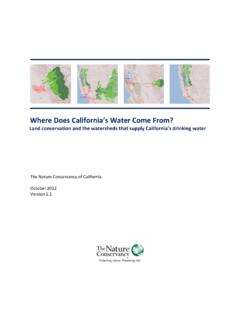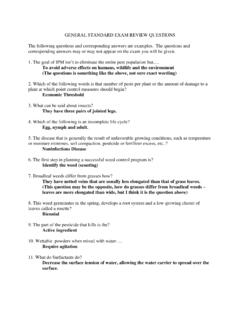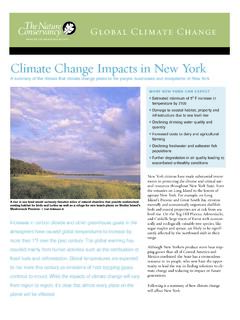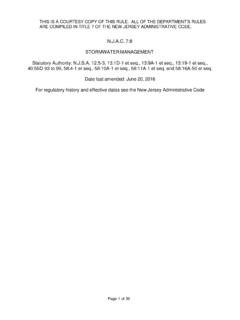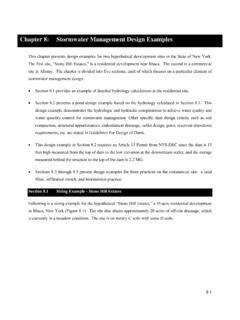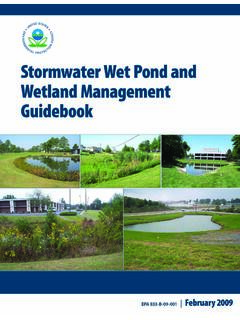Transcription of Mangroves for coastal defence - The Nature Conservancy
1 Mangroves for coastal defenceGuidelines for coastal managers & policy makers 2014 Wetlands International and The Nature ConservancyPublished byWetlands International and The Nature ConservancySuggested CitationSpalding M, McIvor A, Tonneijck FH, Tol S and van Eijk P (2014) Mangroves for coastal defence . Guidelines for coastal managers & policy makers. Published by Wetlands International and The Nature Conservancy . 42 pAbout The Nature ConservancyThe mission of The Nature Conservancy is to conserve the lands and waters upon which all life depends. For general information, visit: For more information about the Mapping Ocean Wealth project, visit: Wetlands InternationalThe mission of Wetlands International is to safeguard and restore wetlands for people and Nature . Wetlands International is an independent, non-profit organisation, active in around 100 countries, which works through a network of many partners and experts to achieve its goals.
2 For more information, visit gratefully acknowledge Mike Beck, Jan van Dalfsen, Joanna Ellison, Filippo Ferrario, Dolf de Groot, Evamaria Koch, Catherine Lovelock, Karen McKee, David McKinnie, Denise Reed, Pam Rubinoff, I. Nyoman Suryadiputra, Norio Tanaka, Trevor Tolhurst, Mai S Tu n, Ty Wamsley, Bregje van Wesenbeeck, Jo Wilson, Han Winterwerp, Eric Wolanski and Colin Woodroffe for their input into the early stages of this research, which they gave either through correspondence, or at the Mangroves as coastal Protection workshop held in Bogor, Indonesia, 19-22 January 2012, or the Natural coastal Protection workshop help in Cambridge, UK, 27-29 March publication was made in the framework of the project Mangrove Capital: `Capturing Mangrove Values in Land Use Planning and Production Systems , with support from the Ministry of Foreign Affairs the Netherlands/ DGIS.
3 This work forms part of the Nature Conservancy s Mapping Ocean Wealth project, a collaborative work to quantify the value of coastal and marine ecosystem services at global to local scales This work is supported through a lead gift from the Lyda Hill drawings were developed by Joost Fluitsma / Jam Visual Design. Photo front cover: Calm water amidst mangrove roots, Berau, Indonesia, by Mark SpaldingPhot back cover: People and property facing coastal hazards in Indonesia, by Stefan Verschure Mangroves for coastal defenceGuidelines for coastal managers & policy makersAuthors: Mark Spalding, Anna McIvor, Femke Tonneijck, Susanna Tol and Pieter van EijkErosionTsunamisSea level riseStorm SurgesWavesContentsPreface 5 Executive summary 6 Section 1.
4 Is my shore at risk? 8 Section 2. The role of Mangroves in coastal risk reduction Mangroves reduce wave damage Mangroves reduce damage from large storms Mangroves can help to reduce tsunami damage Mangroves reduce erosion and bind soils together Mangroves may keep up with sea level rise 22 Section 3. Managing Mangroves for coastal defence Integrating Mangroves into coastal defence strategies Mangroves as part of coastal zone management Bringing the Mangroves back 31 Section 4. Recognising the multiple values of Mangroves 34 Asmat people entirely dependant on Mangroves , Indonesia, by Wetlands InternationalDestruction after typhoon Hayan in the Philippines, by CordaidPrefaceThe role of Mangroves in protecting our coasts against natural hazards such as storms, tsunamis and coastal erosion has been widely acknowledged. Even so, the level of protection provided by Mangroves remains subject to debate.
5 Numerous mangrove restoration projects were instigated after the 2004 East Asian tsunami in the belief that replacing lost Mangroves would reduce future risk, but others raised concerns that not all of these projects were well conceived, and that some might create greater risks by inducing a false sense of security. Can Mangroves reduce waves and storm surges? How will they influence the forces of a tsunami? Do they actually contribute to stabilizing coasts and build-up of soils? Can they keep up with sea level rise? A rich scientific literature exists describing many of these processes, but careful scrutiny is needed to determine what is known or unknown, and what remains Nature Conservancy and Wetlands International together with the University of Cambridge set out to map the current state of knowledge about the role of Mangroves in coastal defence and put the different findings and views in perspective.
6 An extensive review process yielded three technical reports that describe the extent to which Mangroves reduce wind and swell waves, storm surges and erosion and how they build up soils in response to rising sea levels. The conclusion is that Mangroves can indeed reduce risk from a large number of hazards. This practical guidebook summarises the findings of the reviews and provides practical management recommendations to coastal zone managers and policymakers. It helps the reader to assess the risk context in a target area, to define hazard-specific mangrove management interventions and to incorporate these in risk reduction strategies, climate change adaptation protocols and broader coastal development planning. Case studies provide practical examples of mangrove management approaches and references to background information, practical tools for risk assessment and mangrove management are provided throughout the build and bind soils tsunami storm surges planning risk reduction aquaculture sediment waves coast subsidence vulnerability fresh water flow mangrove sea level riseconservation wind Building with Nature greenbelt community management erosion resilience rootsPage 7 PrefaceExecutive summaryThe role of Mangroves in protecting our coasts against natural hazards such as storms, tsunamis and coastal erosion has been widely promoted.
7 But the supposed coastal protection services of Mangroves have also been subject to debate. The Nature Conservancy and Wetlands International together with the University of Cambridge set out to map the current state of knowledge about the role of Mangroves in coastal defence and put the different findings and views in perspective. The conclusion is that Mangroves can indeed reduce the risk from a large number of hazards. This practical guidebook summarises the findings of the reviews and provides practical management recommendations to coastal zone managers and policymakers. These are the key messages:Section 1. Is my shore at risk? coastal managers need to understand risk in terms of hazard, exposure and vulnerability prior to determining what role Mangroves can play The importance of Mangroves in coastal defence and disaster risk reduction will depend both on the site characteristics and the local hazard 2.
8 The role of Mangroves in coastal risk reduction Wind and swell waves are rapidly reduced as they pass through Mangroves , lessening wave damage during storms. Wide mangrove belts, ideally thousands of meters across, can be effective in reducing the flooding impacts of storm surges occurring during major storms (also called cyclones, typhoons or hurricanes). This can significantly reduce flood extent in low lying areas. Narrower mangrove belts, hundreds of meters wide, will still be able to reduce wind speed, the impact of waves on top of the surge and flooding impact to some degree. Wide areas of Mangroves can reduce tsunami heights, helping to reduce loss of life and damage to property in areas behind Mangroves . The dense roots of Mangroves help to bind and build soils. The above-ground roots slow down water flows, encourage deposition of sediments and reduce erosion.
9 Over time Mangroves can actively build up soils, increasing the thickness of the mangrove soil, which may be critical as sea level rise 3. Managing Mangroves for coastal defence Mangroves don t always provide a stand-alone solution; they may need to be combined with other risk reduction measures to achieve a desired level of protection. If they are integrated appropriately, Mangroves can contribute to risk reduction in almost every coastal setting, ranging from rural to urban and from natural to heavily degraded landscapes. For Mangroves to optimally contribute to risk reduction, their conservation needs to be incorporated into broader coastal zone management planning: they need to be protected and restored, allowing wise use where possible. Mangroves , and their coastal risk reduction function, can recover in most places where appropriate ecological and social conditions are present or 4.
10 Recognizing the multiple values of Mangroves Mangroves are among the most valuable ecosystems in the world. Decision makers, and the public, need to take full account of the many benefits that Mangroves provide, and consider the true costs that may incur from mangrove 8 Executive SummaryNatural mangrove in Senegal, by Wetlands InternationalSection 1. Is my shore at risk?To understand whether Mangroves can help to reduce risk on a particular stretch of coast, it is first necessary to assess the risk context in the target area. Risk is a combination of the occurrence of given hazards (frequency, intensity) and the exposure and vulnerability of people to those hazards. coastal lands are subject to multiple natural hazards such as erosion, wave damage, tsunamis, storms and flooding, and over the long-term, rising sea levels. Such hazards may threaten lives, livelihoods, property, health and economic development.
